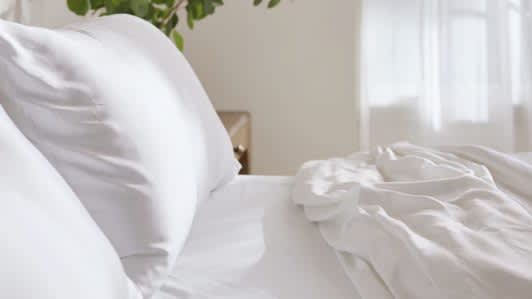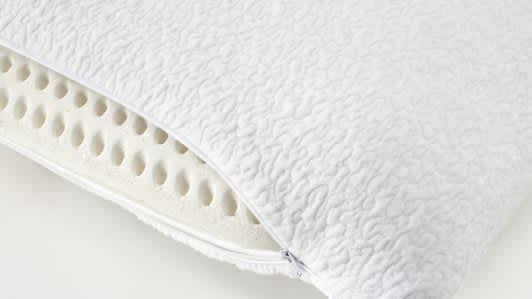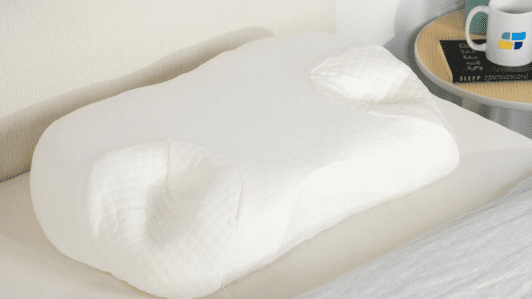On This Page
The Best Pillows for Snoring
Our Top Picks
-
Best Overall
Cozy Earth Bamboo Down Alternative Pillow -
Best Value
Sijo CloudSupport Pillow -
Best Adjustable Loft
Sleep Is the Foundation Shredded Memory Foam Pillow -
Best for CPAP Users
cpaphero Hero CPAP Pillow
Best Overall

The Cozy Earth Bamboo Down Alternative Pillow contains a plush, hypoallergenic blend of polyester fibers and viscose derived from bamboo.
Highlights
Highlights
- Down alternative fill is densely packed to elevate your head and neck
- Bamboo-derived cover sleeps cool and wicks moisture away from your skin
- Standard, king, travel, and body sizes available
Ideal For
- People who are allergic to real down
- Animal-conscious consumers
- Hot sleepers
Full Details
Best Value
Highlights
Highlights
- Latex core is ventilated to promote airflow
- Excellent shape retention and recovery
- Cover is composed of a durable, breathable nylon-spandex blend
Ideal For
- Hot sleepers
- People with frequent neck or shoulder pain
- Shoppers with limited budgets
Full Details
How Does It Feel?
Best Adjustable Loft

Sleep Is the Foundation’s Adjustable Shredded Memory Foam Pillow can be customized to accommodate any sleep position.
Highlights
Highlights
- Adjustable design lets you add or remove fill to customize the firmness and loft
- Cover features side vents to promote airflow and breathability
- Supplemental fill included with each purchase
Ideal For
- Combination sleepers
- People with chronic or frequent neck pain
- Value seekers
Full Details
Best for CPAP Users
Highlights
Highlights
- Dense, solid memory foam keeps your head and neck elevated
- Contoured design supports your CPAP tubing and prevents air leaks
- Two pillowcases included with each purchase
Ideal For
- People who use CPAP therapy
- Those with frequent neck or shoulder pain
- Value seekers
Full Details
How We Trust Pillows
A pillow’s loft, firmness, and moldability can affect the potential for snoring, so we make sure to test for each of these factors in our sleep lab. Our team members, especially those prone to snoring, try each model and score them according to how well the pillow performed for their sleeping position and body weight. We also test every model’s breathability, fill quality, and check how easy it is to clean.
Do Anti-Snore Pillows Work?
While lifestyle changes don’t work for everyone, some people find that using a wedge or special pillow to raise their upper body can reduce or eliminate snoring. Anti-snoring pillows are designed to help sleepers maintain a specific sleeping position or elevate their head and neck to keep the airway more open during sleep.
What Causes Snoring?
Snoring happens when the soft tissues in the upper airway relax during sleep. This narrows the space available in the throat and can restrict the flow of air. As each breath passes through the narrowed airway, the tissues vibrate, creating the sound we refer to as snoring.
Snoring on its own is not usually detrimental to a person’s health, but people who snore loudly or frequently may have an underlying condition called sleep apnea. Without treatment, sleep apnea can lead to a range of health problems. Because of the risks of untreated sleep apnea, it’s always a good idea to speak with a doctor if you or a sleep partner are habitually snoring.
There are a variety of health conditions and other factors that can narrow a person’s airway and contribute to snoring. Understanding an individual’s risk factors for snoring is an important step toward finding appropriate treatment and lifestyle changes that may help.
Common Snoring Causes
| Cause/Condition | Description |
| Sleeping Position/Posture | Sleeping on your back can cause the tongue to relax into the throat and narrow the airway. |
| Mouth, Nose, or Throat Conditions | Certain physical attributes and conditions can obstruct airflow, including a small jaw, a deviated septum, or larger-than-normal tonsils, tongue, or soft palate. |
| Allergies and Congestion | Nasal congestion from a cold or allergies increases the risk of snoring. |
| Alcohol and Tobacco Use | Alcohol relaxes the muscles in the throat, and smoking may contribute to nasal congestion. |
| Age and Weight | Age can weaken muscles in the throat, and people with a higher body weight may have larger necks that put pressure on their airway. |
| Sleep Apnea | Obstructive sleep apnea is a health condition in which a sleeper’s breathing repeatedly stops or becomes severely restricted during sleep. Although most people who snore do not have sleep apnea, most people with sleep apnea snore. |
How Can a Pillow Help Your Snoring?
Pillows that elevate the upper body or encourage side or stomach sleeping can reduce how often people snore. Although there isn’t one way to stop snoring that works for everyone, lifestyle changes can often help by reducing or eliminating factors that contribute to this nighttime symptom.
As the muscles in the mouth, nose, and throat relax during sleep, they can constrict the flow of air and cause tissues in the throat to vibrate. Using an anti-snoring pillow helps to keep the upper airway open by counteracting forces that narrow the airway, like gravity and the movement of body fluids while lying down.
The pillow that works best for snoring varies from sleeper to sleeper as its performance characteristics need to match an individual’s unique sleep needs. Pillows that help with snoring typically include features such as special shapes, adjustable fill, or responsive support to promote healthy sleep posture. Many of the best-selling pillows for snoring check these boxes.
If you can’t train your body to start side sleeping instead of back sleeping (the prime snoring position), you can use a pillow to help. Wedge pillows behind your back encourage side sleeping by preventing you from rolling onto your back./span>
Choosing the Best Pillow for Snoring
Choosing a pillow for snoring involves many of the same considerations that sleepers need to take into account when selecting any other type of pillow. In addition to looking for a pillow that encourages a healthy sleeping position, finding the best pillow means matching a pillow’s loft, firmness, and support to your unique needs.
Sleep Position
Selecting a pillow that complements your sleep position is key. Side sleepers usually require a higher loft and good pressure relief, while stomach sleepers need a lower profile that supports the neck and keeps the spine aligned. Back sleepers looking for an anti-snoring pillow may consider finding one that helps them adjust to sleeping on their side or stomach.
Pillow Types and Materials
Pillow types can be broken down into categories based on their fill. Those who snore will likely do better with a pillow that uses a firmer fill, such as memory foam or latex. Softer fills, like down and down alternatives, don’t offer as much support and may not promote spinal alignment the way a firmer pillow can.
Pillow Height (Loft)
The loft of a pillow refers to how tall it is when resting flat on a sleep surface. Side sleepers generally need a pillow with a high loft, as do back sleepers trying to elevate their upper body. Stomach sleepers typically benefit from a low loft that prevents their neck from bending out of alignment.
Firmness
Firmness is how soft or firm a pillow feels under your head. The softer the pillow is, the more it will compress under the weight of your head. Conversely, firmer pillows hold their shape. The ideal firmness for each person depends on their sleep position, weight, and individual preferences.
Support
A pillow’s level of support is defined as how well it facilitates a healthy sleep position and good spinal alignment. Influenced by its loft, firmness, and construction, a pillow with good support is one that contours to the head and neck and has the right level of firmness for a sleeper’s needs.
Pillow Shape
A standard pillow is rectangular, but pillows come in a wide variety of shapes. Many anti-snoring pillows come in non-standard shapes like wedges in order to encourage a specific sleep posture that will minimize snoring. They also tend to be ergonomically designed to comfortably accommodate the neck, head, and shoulders.
Pressure Relief
Pressure relief describes how well a pillow minimizes tension in the body. Memory foam and latex pillows are particularly known for their pressure-relieving capability. This means they conform to the curves of the body and support the spine, eliminating potential pain points resulting from poor alignment.
Moldability
Moldability refers to how much a pillow can be shaped to accommodate a sleeper’s unique needs and preferences. Down and down alternative pillows are highly moldable, while solid memory foam and latex pillows are much less so.
Temperature Regulation
Pillows regulate temperature by maintaining a comfortable sleep surface. Some have built-in cooling technology designed to wick away heat, while others have materials that promote airflow. Many pillows incorporate a combination of these temperature-regulating tools.
Speciality Pillows for Snoring
Choosing a pillow with the right shape, loft, firmness, and support can go a long way toward reducing snoring. Specialty pillows for snoring often have non-standard features or shapes that are designed to accommodate the needs of these specific sleepers.
-
Adjustable fill pillows: Pillows with adjustable fill have a zippered cover that allows sleepers to either remove or add to the fill inside to create a personalized level of loft.
-
Wedge pillows: Gently sloping with a firmer feel, wedge pillows work especially well for back sleepers seeking to elevate their upper body during sleep to prevent snoring.
-
Cervical pillows: These pillows are either fully cylindrical or incorporate a raised cylindrical shape near the front edge. This shape is designed to fit against the curve of the neck and encourage good spinal alignment.
-
Pillows that promote side sleeping: Side sleeping pillows are designed to accommodate the shoulders while also supporting the head and neck. Body pillows that tuck in behind sleepers can add support and encourage side sleeping to help with snoring.
-
CPAP pillows: Snorers with sleep apnea may need to use a CPAP machine. Pillows designed for CPAP users often feature cutouts that fit a mask and hose.
- Smart pillows: Smart pillows are an emerging technology that detect snoring and the position of the head. They then inflate internal airbags to gently turn the head to the side and open the airway.
Adjustable fill pillows are a really cool innovation that can help you fine-tune your loft level and get it exactly where you need it to keep your airways open and prevent snoring.
Last Tips for Dealing With Snoring
Changing the pillow you use is only one method that may help reduce snoring. Other strategies include getting personalized advice from your doctor and reducing both tobacco use and alcohol intake.
Speak with your doctor: Your physician can determine if your snoring is related to sleep apnea and recommend any necessary treatment or a sleep test. Some snoring treatments are only available by prescription, like CPAP machines for sleep apnea and certain anti-snoring mouthpieces. Doctors may also recommend myofunctional therapy to increase muscle tone in your mouth, tongue, and throat.
Adjust your sleeping position and posture: Back sleeping can contribute to snoring, but some research suggests that sleeping on your side or with your upper body elevated may be beneficial. There are a variety of strategies to raise your head and neck or adjust to sleeping on your side, including putting a pillow behind your back and using an adjustable bed base.
Lifestyle changes: Other lifestyle changes to reduce snoring depend on an individual’s unique risk factors. For example, people diagnosed with obesity can talk to their doctors about whether weight loss may reduce their snoring. Additionally, people who smoke and drink alcohol before bed can talk to their doctors to get support for reducing these and other factors that exacerbate snoring.
Explore More Pillows
If you’re looking for a particular type of pillow, check out our other guides below.


